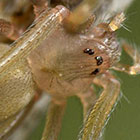Sicariids are six-eyed spiders known for their necrotic (flesh-eating) bites. There are only two genera, Loxosceles and Sicarius The family ontains about 132 species world wide. The genus Loxosceles (recluse or violin spiders) is found worldwide in warmer areas. They are usually brownish with a darker brown violin marking on the cephalothorax. Sicarius spp. are desert spiders in South America and Africa known primarily for their self-burying behavior. They resemble the crab spiders of the family Thomisidae and lack the violin marking. Both genera have potent tissue-destroying toxins containing the dermonecrotic agent, sphingomyelinase D, which is otherwise found only in a few pathogenic bacteria, capable of causing lesions (open sores) as large as 25mm in diameter. The wounds take a long time to heal and may require skin grafts. If these open wounds get infected there can be serious consequences including systemic (whole of body and organs) poisoning.
Loxosceles rufescens
This recluse spider is fairly well established in South Australia, found in and around houses and sheds. Its bite is medically important, capable of... 


